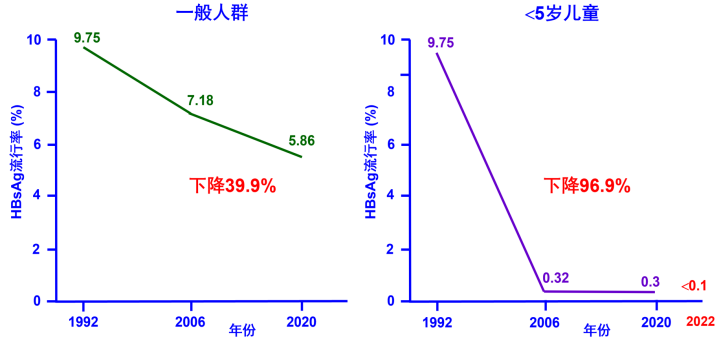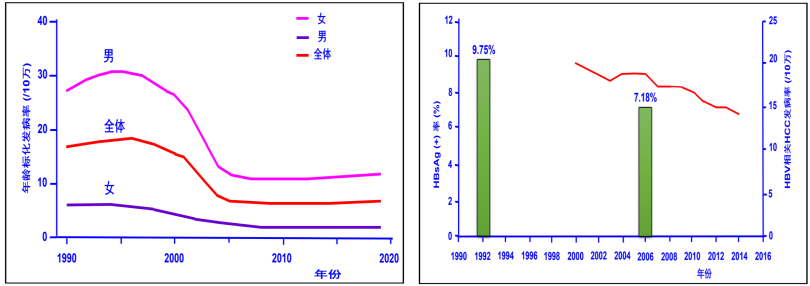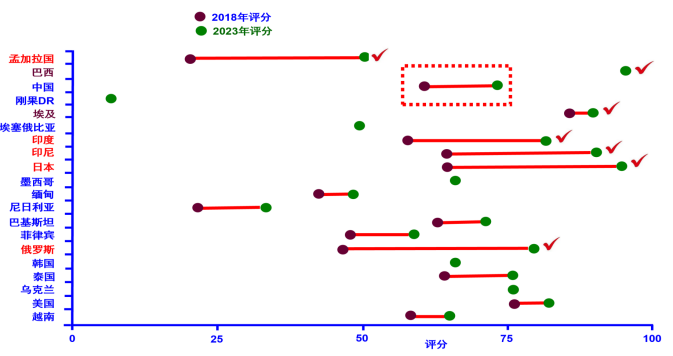我国消除乙肝进展 视线回到中国,庄院士指出:我国乙肝的免疫预防工作一直成绩不错。在过去的30年里,中国在降低乙肝发病率方面取得了良好的进展,我国急性乙肝年龄标化发病率自1990年至2019年下降48.7%(图4);我国一般人群HBsAg流行率持续下降(由1992年的9.75%降至2020年的5.86%),特别是我国5岁以下儿童HBsAg流行率降幅最大,2022年已降至0.1%(图5),已处于全球最低水平国家之一;我国乙肝相关HCC年龄标化发病率也在逐年显著下降(图6)。放眼全球,我国的乙肝消除成绩也有名列前茅的,尤其是3针乙肝疫苗接种率高达99.6%,首针及时接种率达95.6%,为全球最佳(表3)。

图4. 我国急性乙肝年龄标化发病率变化[12] (引自讲者幻灯)

图5. 我国HBsAg流行率变化情况[4,13] (引自讲者幻灯)

图6. 我国乙肝相关HCC年龄标化发病率[14-15] 表3. 我国消除乙肝进展 (2022年) 
(引自讲者幻灯) 然而,由于我国感染乙肝病毒的人群基数较大,我国所有年龄人群HBsAg流行率虽有下降,成人急性乙肝发病率却相对较高(图7);此外,2020年全国乙肝血清流行病学调查结果显示,我国成人HBV易感率高,15岁以上人群HBV易感率高于20%(图8)。因此,消除乙肝,我们肩上的压力依然不轻。

图7. 我国成人急性乙肝发病率[16] (引自讲者幻灯)

图8. 2020年全国乙肝血清流行病学调查结果[17] (引自讲者幻灯) HBV感染筛查是减少乙肝危害的关键措施之一。因此,扩大筛查范围,提高诊断率和治疗率,成为加速消除乙肝的必由之路。通过筛查乙肝表面抗原(HBsAg)、乙肝核心抗体(抗-HBc)和乙肝表面抗体(抗-HBs),对HBsAg阳性者作进一步诊断和治疗,并同时进行HCC监测,做到早发现、早根治;对上述3项标志物均阴性者接种乙肝疫苗;对单项抗-HBc阳性者评价其再活动风险,确定在免疫抑制剂等治疗前是否需要抗病毒治疗。有效的乙肝筛查可提高乙肝的诊断率和治疗率,降低死亡率和发病率[18-20]。

图9. 筛查可提高诊断率和治疗率、降低死亡率 (引自讲者幻灯)
写在最后 庄院士在总结中,引用了近日Lancet Gastroenterology & Hepatology杂志新发表的全球乙肝消除进展报告,文章对20国消除乙肝进展进行了综合评价,其中我国2023年评分约75分(vs. 2018年60分),仍有很大进步空间。文章指出,我国急需制定国家级消除乙肝行动计划,提高对病毒性肝炎的公众意识和教育,对大规模检测和治疗计划需提供资源支持,消除乙肝歧视和污名化,降低乙肝患者得诊疗费用等。综上所述,我们在消除乙肝的道路上,革命尚未成功,攻坚克难仍应继续。

图10. Lancet Gastroenterology & Hepatology Commission对20国消除乙肝评价 (引自讲者幻灯) 参考文献:(上下滑动查看更多) 1. Polaris Observatory Collaborators. Global prevalence, cascade of care, and prophylaxis coverage of hepatitis B in 2022: a modelling study. Lancet Gastroenterol Hepatol, 2023, 8(10):879-907.2. GBD 2019 Hepatitis B Collaborators. Global, regional, and national burden of hepatitis B, 1990-2019: a systematic analysis for the Global Burden of Disease Study 2019. Lancet Gastroenterol Hepatol,2022, 7(9):796-829.3. Cui F, et al. Global reporting of progress towards elimination of hepatitis B and hepatitis C. Lancet Gastroenterol Hepatol, 2023, 8(4):332-342.4. Polaris Observatory Collaborators. Global prevalence, cascade of care, and prophylaxis coverage of hepatitis B in 2022: a modelling study. Lancet Gastroenterol Hepatol, 2023, 8(10):879-907.5. Progress report on HIV, viral hepatitis and sexually transmitted infections 2021: accountability for the global health sector strategies, 2016–2021: actions for impact. Geneva: World Health Organization; 2021.6. https://cdafound.org/dashboard/polaris/dashboard.html.7. https://cdafound.org/dashboard/polaris/dashboard.html.8. WHO/UNICEF joint reporting process. Geneva: World Health Organization/UNICEF; 2019.9. Cooke GS, et al. Progress towards elimination of viral hepatitis: a Lancet Gastroenterology & Hepatology Commission update. Lancet Gastroenterol Hepatol, 2024, 9(4):346-365.10. US CDC. 2023 Viral Hepatitis National Progress Report. 2024.11. Su X, et al. Secular Trends of Acute Viral Hepatitis Incidence and Mortality in China, 1990 to 2019 and Its Prediction to 2030: The Global Burden of Disease Study 2019. Front Med (Lausanne), 2022, 9:842088.12. Yue T, et al. Trends in the disease burden of HBV and HCV infection in China from 1990-2019. Int J Infect Dis, 2022, 122:476-485.13. Shi JF, et al. Is it possible to halve the incidence of liver cancer in China by 2050? Int J Cancer, 2021, 148(5):1051-1065.14. 张国民, 等. 中国2005-2016年乙型病毒性肝炎报告发病的年龄和地区特征. 中国疫苗和免疫, 2018, 24(2): 121-126.15. 郑徽, 等. 2020年全国乙型肝炎血清流行病学调查 (待发表), 2023.16. So S, et al. JAMA, 2023, 329(19):1639-1640.17. Conners EE, et al. Screening and Testing for Hepatitis B Virus Infection: CDC Recommendations - United States, 2023. MMWR Recomm Rep, 2023, 72(1):1-25.18. Su TH, et al. Improving clinical outcomes of chronic hepatitis B virus infection. Expert Rev Gastroenterol Hepatol, 2015, 9(2):141-154.
(来源:《国际肝病》编辑部) |